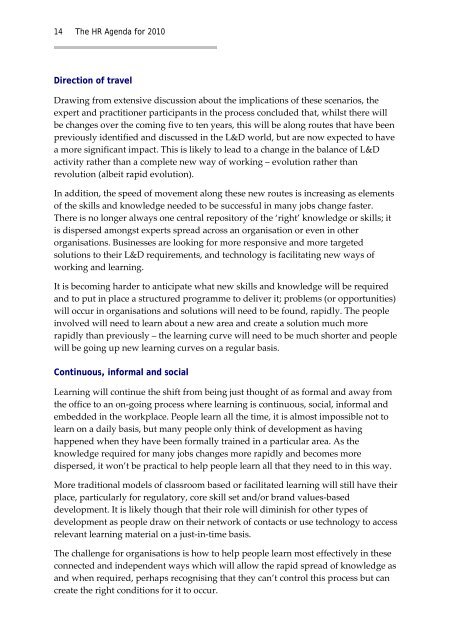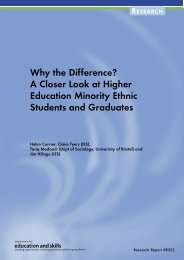PDF of this item - The Institute for Employment Studies
PDF of this item - The Institute for Employment Studies
PDF of this item - The Institute for Employment Studies
- No tags were found...
You also want an ePaper? Increase the reach of your titles
YUMPU automatically turns print PDFs into web optimized ePapers that Google loves.
14 <strong>The</strong> HR Agenda <strong>for</strong> 2010Direction <strong>of</strong> travelDrawing from extensive discussion about the implications <strong>of</strong> these scenarios, theexpert and practitioner participants in the process concluded that, whilst there willbe changes over the coming five to ten years, <strong>this</strong> will be along routes that have beenpreviously identified and discussed in the L&D world, but are now expected to havea more significant impact. This is likely to lead to a change in the balance <strong>of</strong> L&Dactivity rather than a complete new way <strong>of</strong> working – evolution rather thanrevolution (albeit rapid evolution).In addition, the speed <strong>of</strong> movement along these new routes is increasing as elements<strong>of</strong> the skills and knowledge needed to be successful in many jobs change faster.<strong>The</strong>re is no longer always one central repository <strong>of</strong> the ‘right’ knowledge or skills; itis dispersed amongst experts spread across an organisation or even in otherorganisations. Businesses are looking <strong>for</strong> more responsive and more targetedsolutions to their L&D requirements, and technology is facilitating new ways <strong>of</strong>working and learning.It is becoming harder to anticipate what new skills and knowledge will be requiredand to put in place a structured programme to deliver it; problems (or opportunities)will occur in organisations and solutions will need to be found, rapidly. <strong>The</strong> peopleinvolved will need to learn about a new area and create a solution much morerapidly than previously – the learning curve will need to be much shorter and peoplewill be going up new learning curves on a regular basis.Continuous, in<strong>for</strong>mal and socialLearning will continue the shift from being just thought <strong>of</strong> as <strong>for</strong>mal and away fromthe <strong>of</strong>fice to an on‐going process where learning is continuous, social, in<strong>for</strong>mal andembedded in the workplace. People learn all the time, it is almost impossible not tolearn on a daily basis, but many people only think <strong>of</strong> development as havinghappened when they have been <strong>for</strong>mally trained in a particular area. As theknowledge required <strong>for</strong> many jobs changes more rapidly and becomes moredispersed, it won’t be practical to help people learn all that they need to in <strong>this</strong> way.More traditional models <strong>of</strong> classroom based or facilitated learning will still have theirplace, particularly <strong>for</strong> regulatory, core skill set and/or brand values‐baseddevelopment. It is likely though that their role will diminish <strong>for</strong> other types <strong>of</strong>development as people draw on their network <strong>of</strong> contacts or use technology to accessrelevant learning material on a just‐in‐time basis.<strong>The</strong> challenge <strong>for</strong> organisations is how to help people learn most effectively in theseconnected and independent ways which will allow the rapid spread <strong>of</strong> knowledge asand when required, perhaps recognising that they can’t control <strong>this</strong> process but cancreate the right conditions <strong>for</strong> it to occur.
















